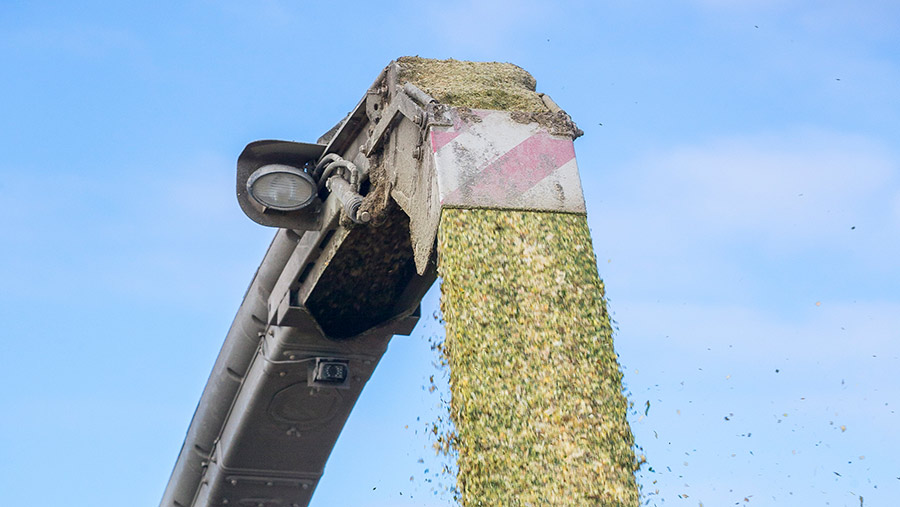Maize Watch: Harvest begins with yields off to a promising start
 © Gary Naylor
© Gary Naylor As foragers start chopping maize crops across the South and East, reports are that yields are very good, ranging between 43 and 48t/ha.
Excellent growth throughout the summer was due to July and August rainfall, according to Grainseed manager Neil Groom.
This is allowing growers to replace their forage stocks and build up a carry over into 2024. Neil says that maize is being sealed and allowed to ferment rather than being fed fresh out of the clamp at harvest.
The grain set and cob size this year are also excellent: “Many growers have filled their clamps with grass throughout summer and are looking forward to feeding quality maize [alongside it] this autumn,” he says.
See also: Maize crops perform well in this year’s challenging weather
Cutting height
“Where crops are massive, consider raising the cutting height so that the cob and grain become a greater proportion of the silage clamped.”
Neil explains the lowest part of the stem is the most lignified, so cutting at 45cm, and leaving this less digestible stalk in the field, will improve overall forage digestibility.
“[At this height] the root ball and lower stalk can still be ploughed in easily,” he adds.
Dry matters on the English trial sites have increased by an average of 3.6% – well above the commonplace 2% a week.
This is a continuation of the increased maturity seen at the beginning of the month when the weather was hot.
“The maize wants to finish now and put all its energy into seed and starch production. Wait for the crop to finish naturally, as starch is being rapidly laid down in the grains at the moment,” says Neil.
“This will ensure top-quality maize silage for feeding and improved production, since the cows will eat more and therefore produce more milk and meat.”
Fields that had been undersown with grass in June are keeping harvesters and trailers clean and reducing the amount of soil leaving the field, adds Maize Growers Association agronomist Jon Myhill.
Winter cover
Once a maize field has been harvested, he encourages sowing a crop to protect the soil from weathering over winter.
Where maize is rotated within an arable enterprise, winter wheat is common. Otherwise, he says, Westerwold, Italian ryegrass or forage rye can be drilled to use available nutrients and hold the soil particles together.
“If maize has been cut in dry conditions, then sowing can be simply by a tined seeder, but if the field becomes wet, or trailers have caused ruts, then a set of discs or heavier tines will be needed to remove compaction from the soil structure.”
Soils are still warm and grass seeds will germinate and establish rapidly this autumn to provide a useful early bite next spring before the main grazing platform is grazed, says Jon.
2023 growing season: Progress of maize crops on six sites in England, Scotland and Wales |
||||
|
Site |
Drill date |
Height above sea level (m) |
Crop dry matter 12 September |
Increase from last week |
|
Petworth, West Sussex |
7 May |
50 |
33.6% |
+4.4 |
|
Harleston, Norfolk |
18 May |
30 |
24.6% |
+3.9 |
|
Crediton, Devon |
22 April |
118 |
33.1% |
+4.7 |
|
Ticknall, Derbyshire |
8 May |
67 |
26.9% |
+1.5 |
|
Narbeth, South Wales |
4 May |
32 |
No sample yet |
NA |
|
SRUC, Dumfries, Scotland (Samco film) |
24 April |
45 |
25.8% |
-0.9 |
|
SRUC, Dumfries, Scotland (conventional) |
10 May |
45 |
No sample yet |
NA |
| Variety: Faith. Variety under film: Palladium. Source: Grainseed | ||||
